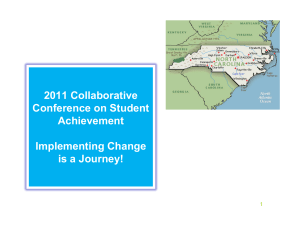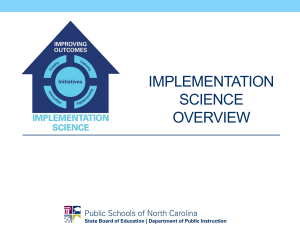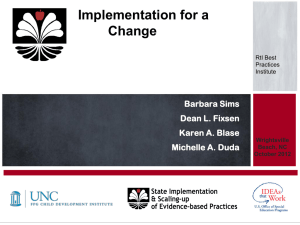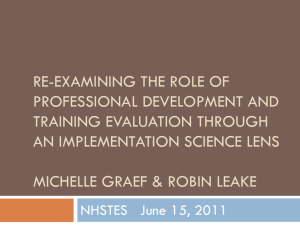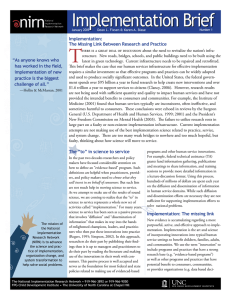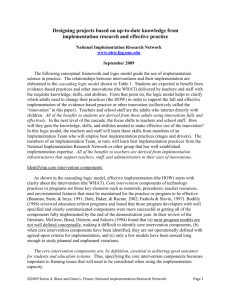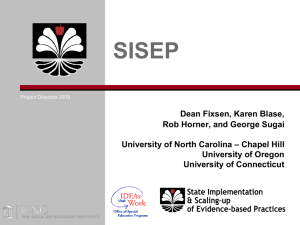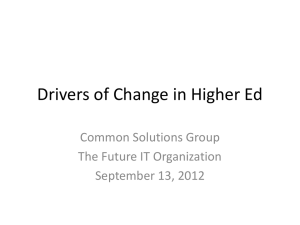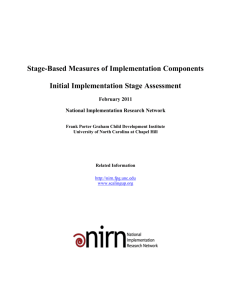Building Implementation Capacity to Improve Youth Outcomes
advertisement
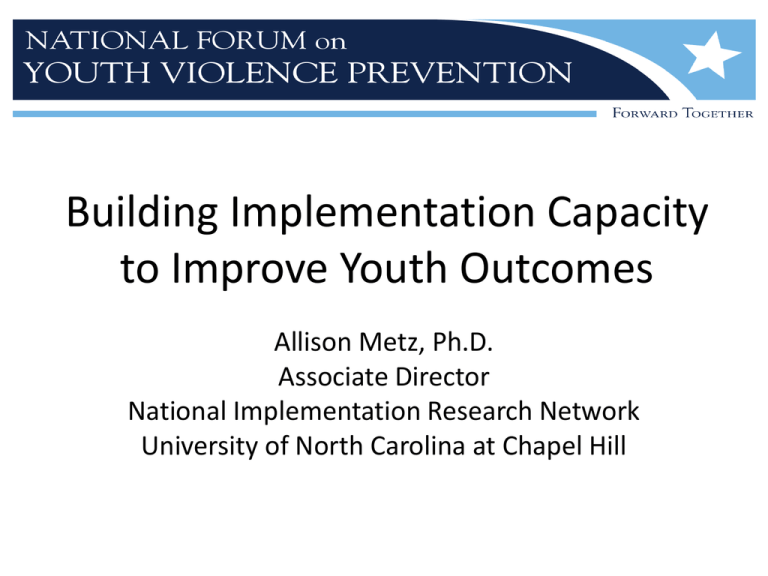
Building Implementation Capacity to Improve Youth Outcomes Allison Metz, Ph.D. Associate Director National Implementation Research Network University of North Carolina at Chapel Hill Agenda • The Challenge • Implementation Science • Plan for Change • Active Implementation Frameworks The Challenge: Recognizing the Gaps • Science to Service Gap – What is known to be effective is not what is selected to help students • Implementation Gap – What is selected is not used with fidelity and good outcomes – What is used with fidelity is not sustained for a useful period of time – What is used with fidelity is not used on a scale sufficient to broadly impact youth outcomes Implementation Gap RESEARCH IMPLEMENTATION PRACTICE Implementation is defined as a specified set of activities designed to put into practice an activity or program of known dimensions. Why Focus on Implementation? RESEARCH IMPLEMENTATION GAP PRACTICE “Children, youth, and families cannot benefit from interventions they do not experience.” IMPLEMENTATION INTERVENTION Effective Effective NOT Effective MarkInconsistent; Lipsey’s 2009 Meta-analytic Actual from overview Not of theSustainable; primary factors that characterize effective juvenile offender Poor Benefitsinterventions – outcomes “. . . in some analyses, the quality with which the intervention is Poor hasoutcomes; been as strongly NOT Effective Unpredictable orimplemented poor outcomes;related to Sometimes harmful recidivism effects as the type of program, so much so that a well-implemented intervention of an inherently less efficacious type can outperform a more on (Institute of Medicine, 2000; 2001; 2009; New Freedom Commission efficacious one thatinis poorly Mental Health, 2003; National Commission on Excellence Education,1983; Department of Health implemented.” and Human Services, 1999) “Implementation Science” “Implementation science is the systematic study of variables and conditions that lead to full and effective use of evidence-based programs and other effective innovations in typical human service settings.” —Blase and Fixsen, 2010 National Implementation Research Network Download at: http://www.fpg.unc.edu/~nirn/resources/publications/Monograph/ Best data show these methods, when used alone Do not Result in Implementation as Intended – Diffusion/ Dissemination of information – Training – Passing laws/ mandates/ regulations – Providing funding/ incentives – Organization change/ reorganization 5 to 10% return on investment NECESSARY BUT NOT SUFFICIENT Plan for Change: “Making It Happen” Letting it happen – Recipients are accountable Helping it happen – Recipients are accountable Making it happen – Purposeful use of implementation practice and science – Implementation teams are accountable —Based on Hall & Hord (1987); Greenhalgh, Robert, MacFarlane, Bate, & Kyriakidou (2004); Fixsen, Blase, Duda, Naoom, & Van Dyke (2010) To successfully implement and sustain evidence-based and evidence-informed youth violence prevention interventions, we need to know: WHAT to do What is the intervention (e.g.identified prevention, intervention and enforcement strategies that are feasible and relevant)? HOW to do it Active and effective implementation and sustainability frameworks (e.g. strategies to change and maintain behavior of adults) WHO will do it Organized, purposeful, & active implementation support from linked implementation teams Q. How? A. Effective Implementation • • • • Changing the behavior of practitioners and administrators Creating the setting conditions to facilitate these changes Creating the processes to maintain and improve these changes in both setting conditions and behavior of wellintentioned adults So that youth benefit Active Implementation Frameworks Implementation Drivers Implementation Stages Improvement Cycles Implementation Teams IMPLEMENTATION DRIVERS Common features of successful supports to help make full and effective use of a wide variety of innovations Positive Outcomes for Youth Effective Youth Violence Prevention Practices Staff capacity to support youth with the selected practices Institutional capacity to support practitioners in implementing practices with fidelity Core Implementation Components Leadership Capacity to provide direction and vision © Fixsen & Blase, 2008 Improved youth outcomes Consistent Use of Prevention Innovations Interventions meet Implementation Performance Assessment (Fidelity) Systems Intervention Coaching Training Selection Adaptive Integrated & Compensatory Technical Facilitative Administration Decision Support Data System Leadership © Fixsen & Blase, 2008 IMPLEMENTATION STAGES Purposeful matching of critical implementation activities to the stage of the process Drivers Drivers Drivers Stages AND Drivers “DRIVERS” EXPLORATION Integrated & Compensatory Leadership Drivers Stages of Implementation —Fixsen, Naoom, Blase, Friedman, & Wallace, 2005 Goals of Exploration • Create readiness for change • • • Changing hearts and minds Examine degree to which the proposed strategies and practices meet the needs of our community and our youth Determine whether the strategies, practices, and implementation are desirable and feasible The Hexagon An EBP Exploration Tool The “Hexagon” can be used as a planning tool to evaluate evidencebased programs and practices during the Exploration Stage of Implementation. Download available at: www.scalingup.org/tools-and-resources Need in school, district, state • Academic & socially significant Issues • Parent & community perceptions of need • Data indicating need Capacity to Implement • • Staff meet minimum qualifications Able to sustain Imp Drivers • Financially • Structurally Buy-in process operationalized • Practitioners • Families • NEED Fit with current Initiatives • School, district , state priorities • Organizational structures Community values CAPACITY FIT EBP: 5 Point Rating Scale: High = 5; Medium = 3; Low = 1. Midpoints can be used and scored as a 2 or 4. High Med Low READINESS Fit Resources and supports for: Readiness for Replication • • • • • • Need RESOURCES Qualified purveyor Expert or TA available Mature sites to observe Several replications How well is it operationalized? Are Imp Drivers operationalized? EVIDENCE • • • • • • • Curricula & Classroom Technology supports (IT dept.) Staffing Training Data Systems Coaching & Supervision Administration & system Resource Availability Evidence Evidence Readiness for Replication Capacity to Implement • • • • • • • Outcomes – Is it worth it? Fidelity data Cost – effectiveness data Number of studies Population similarities Diverse cultural groups Efficacy or Effectiveness Total Score © National Implementation Research Network 2009-2012 Adapted from work by Laurel J. Kiser, Michelle Zabel, Albert A. Zachik, and Joan Smith at the University Integrated & Compensatory Leadership Drivers Stages of Implementation —Fixsen, Naoom, Blase, Friedman, & Wallace, 2005 Goals of Installation • • • • • • Structural and functional changes are made to support implementation Staff selection protocols developed First ‘practitioners’ selected Define and initiate training of first cohort of practitioners Develop coaching system and plans Evaluate readiness and sustainability of data systems (e.g. fidelity, outcomes) INITIAL IMPLEMENTATION Integrated & Compensatory Leadership Drivers EXPLORATION Stages of Implementation Fixsen, Naoom, Blase, Friedman, & Wallace, 2005 Goals of Initial Implementation • • • • • Work through the Awkwardness Provide training and coaching on the evidence-based practice, re-organization of school roles, functions and structures Make use of improvement cycles to resolve systems issues Continue buy-in efforts and manage expectations All the components of the program or innovation are at least partially in place and the implementation supports begin to function FULL IMPLEMENTATION 2-4 Years Stages of Implementation Fixsen, Naoom, Blase, Friedman, & Wallace, 2005 Goals of Full Implementation • • • • • Maintaining and improving skills and activities throughout the system Components integrated, fully functioning Skillful practices by front line staff, supervisors, administrators (50% meet performance criteria) Changes in policy are reflected in practice at all levels Ready to be evaluated for expected outcomes IMPROVEMENT CYCLES Changing on purpose to support the new way of work PDSA Cycles Improvement Cycles Act Plan Study Do • • • New practices do not fare well in existing organizational structures and systems Effective innovations are changed to fit the system, as opposed to existing systems changing to support effective innovations. People, organizations, and systems. . . • Cannot change everything at once (too big; too complex; too many of them and too few of us) • Cannot stop and re-tool (have to create the new in the midst of the existing) • Cannot know what to do at every step (we will know it when we get there) • Many outcomes are not predictable (who knew!?) • Plan-Do-Study-Act Cycles Rapid cycle problem solving (Shewhart; Deming) Transformation Zone Usability testing (Neilson; Rubin) Practice-policy communication loops Practice-Policy Communication Cycle Feedback Practice Informs Policy Policy Enables Practices Plan Study - Act External Implementation Support Policy Do Practice FORM SUPPORTS FUNCTION Policy Structure Procedure Practice IMPLEMENTATION TEAMS Organized, expert assistance to develop and sustain an accountable and effective structure Implementation Teams • Provide accountable and effective structure to move intervention through stages of implementation • Scope of the initiative determines the number of teams and the linked communication protocols needed • Focus is on – – – – – Ongoing “buy-in” and readiness Installing and sustaining the Implementation Drivers Fidelity & Outcomes Systems Alignment and Stage-based work Problem-solving and sustainability Implementation Teams Linked Team Structures “We tend to focus on snapshots of isolated parts of the system and wonder why our deepest problems never seem to get solved.” —Senge, 1990 State-based Implementation Team Regionally-based Implementation Team Community-based Implementation Team Site-based Implementation Team Implementation Teams CORE COMPETENCIES Team Structure Know the Intervention Know Implementation Know Improvement Cycles Know Systems Change Who Makes Change Happen? • INDICATORS • Representative • Accountable SO THAT... …can effect change throughout the system and make decisions • Formal/Practice Knowledge • Model fluency • Fully operationalize Intervention …can promote implementation • Best practices for Implementation Core components • Stage-appropriate Work …can guide implementation and build capacity throughout the organization and system • Communicate Change • Use of data for decision making, problem solving and feedback loops • Knowledge and skills for system building and components of core components, adaptations, and infrastructure …can develop and followthrough on action planning …can support efforts to improve access, reach or scale, improve connection, influence decisionmaking Examples of Success Implementation results (higher fidelity) and intervention results (improved outcomes) improve when Active Implementation Frameworks are used purposefully and systematically • Catawba County Child Wellbeing Project- 5 year period to develop, implement and evaluate post-care service system for children exiting foster care; high fidelity and early indicators of success • Colorado EPIC Project- Scale-up of MI using Active Implementation Frameworks in corrections • EPIS Center at Penn State University - 419 age-grade cohorts over a 5-year period: youth in CTC communities using EBPs had significantly lower rates of delinquency, greater resistance to negative peer influence, stronger school engagement and better academic achievement • Evidence-Based Model Purveyors – NFP, MST, FFT use many components of active implementation frameworks to achieve sustainable outcomes Summary: “Making it Happen” for youth Purposeful selection of an effective and feasible “What” Conceptualize a change process so that effective interventions for children and families can become embedded and sustained in socially complex settings “stage-matched activities” to guide the process “implementation drivers” to build the infrastructure Improvement processes are critical the work is never done because the environment is in motion Invest in the development of organized, “expert” implementation support Stay Connected! Allison.metz@unc.edu nirn@unc.edu nirn.fpg.unc.edu www.scalingup.org www.implementationconference.org
